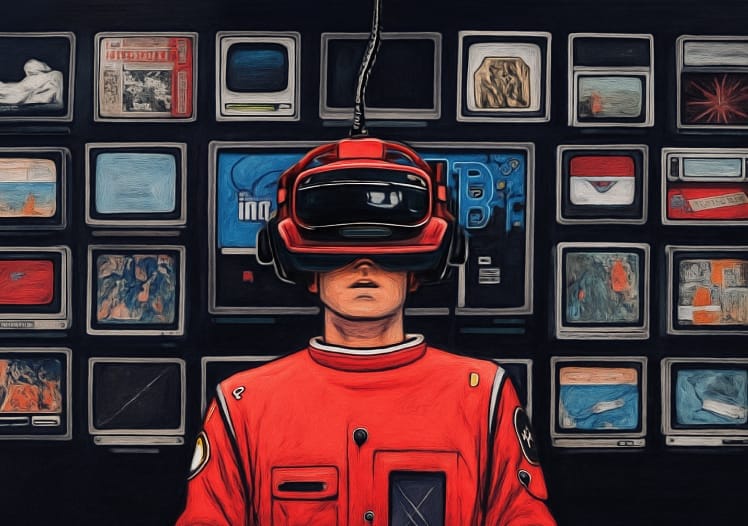Think about the last movie you watched.
Did it stay with you? Was there a moment that touched your heart, made you pause, or sparked a conversation days later? Or did you walk out of the cinema—or switch off the TV—remembering only the dazzling CGI, the fight scenes, or the visual spectacle, while the story itself quickly slipped away?
That difference isn’t accidental.
Neuroscience research by Cahill & McGaugh (1998) shows that when emotions are triggered, the amygdala activates and releases neurotransmitters like dopamine, strengthening the brain’s ability to consolidate memories.
| We remember what moves us emotionally.
Learning works in exactly the same way. Information on its own is easily forgotten like a film with impressive visuals but no ‘soul’. But when learning is designed to create emotional connection (when learners are drawn into a story, a scenario, or a challenge) the experience lingers, influences behaviour, and becomes part of their own narrative.
In the corporate world today, knowledge and learning materials come in many forms: training decks, recorded leadership talks, policy manuals, SME notes, frameworks, customer service guides etc. So how do you transfer that knowledge and create positive change within the organisation?
Yes, you can build a course. Launch it on the LMS. Track completions. Everything seems correct. But in practice? Nothing changes.
Because content delivery ≠ behaviour change.
The missing ingredient is “connection”, the bridge between content and capability. In the high-stakes environments where L&D leaders operate, connection is no longer optional. It’s the differentiator between training that’s forgotten the moment the course ends, and learning that transforms culture and performance.

From Theory to Practice: What Connection Looks Like
To build that connection, we need the Learning Architect mindset that transforms even the most well-intentioned content into emotionally resonant experiences that stick with learners, shift behaviours, and drive real business outcomes.
Below are a few examples of how the Visuer team applied the Learning Architect mindset to design experiences that build real connection.
Through thoughtful learning design, we transformed existing materials into journeys that engage emotionally, make knowledge feel relevant, and give learners the confidence to apply what they have learned.
Course #1: Sales Enablement
From Frameworks to Decisions that Stick

The Challenge
The sales enablement team had a solid internal framework, a step-by-step guide for leading customer conversations. But the feedback from training is that it wasn’t sticking. New hires either improvised under pressure or skipped steps altogether.
The Design Insight
This wasn’t a knowledge gap. It was a transfer gap.
The framework is ready but couldn’t apply them when it mattered.
Our Approach
We reimagined the framework as a branching scenario set on a familiar retail floor. Instead of just reading steps, learners stepped into the moment. They had to navigate real dialogue, handle emotional cues, and make choices that mirrored live pressure.
What we focused on:
- Re-mapped the framework into conversational beats.
- Layered in subtle emotions: impatience, doubt, pushback.
- Designed decision points that made learners stop and think:
“Would I actually say this?”
“What happens if I do?”
The Result
Confidence went up. Learners no longer just remembered the framework, they used it.
Managers saw better flow in sales conversations, and team huddles shifted from reminders to peer coaching.
↳ So, if you already have the framework…
And you want your team to live it, not just learn it, you may consider recreating the real-world messiness. Bring the pressure, and build decision-making into practice. That’s how knowledge becomes action.
Course #2: Financial Literacy
Turning Concepts into a Story Learners Can Live Through

The Challenge
An education team wanted to equip young professionals and students with financial fundamentals i.e. budgeting, saving, managing debt, understanding risk and diversification. The delivery was dense, theoretical, and hard to digest, as early learners shared their feedback: “…feels overwhelming.”
Our Approach
We shifted from content-heavy explanations to a narrative learning experience.
Instead of teaching terms, theory and definitions, we followed the journey of a character navigating her first job, paycheck, and real financial decisions.
Design choices we made:
- Concepts were discovered through a journey. Learners encountered saving, debt, and investing through moments in the story.
- Abstract ideas were made tangible with metaphors like “money buckets”, “financial weather”, and “financial fuel tanks.”
- Interactive prompts encouraged reflection:
“If this were you, what would you do next?”
“How would you split your first paycheck?”
The Result
Learners felt immersed and in control.
Engagement climbed, completion rates crossed 85%, and post-assessments showed learners could not only recall terms but confidently apply them to their own lives.
↳ So, if you’re working with complex concepts…
don’t just explain them, but story them.
Whether it’s cybersecurity, sustainability, or leadership, wrap it in a journey, reframe your content as moments of decision, emotion, and consequence. You could frame it as a sci-fi mission, a survival quest, or even a dating app dilemma, whatever helps learners see themselves in the story.
That’s when learning sticks.
Course #3: Future Skills Simulation
Reimagining professional skills through a sci-fi mission framework and mentor-led learning.

The Challenge
A global organisation wanted to future-proof their workforce with stronger conflict resolution and collaboration skills based on their policy guides and behaviour frameworks.
But they lacked traction. The learning felt like a checklist. Learners weren’t connecting, and the skills weren’t transferring.
Our Approach
We reframed the training as a mission-based simulation set in a futuristic world where learners joined an elite “Alliance for Integrity”, a storyline that mirrored real workplace dilemmas through allegory.
Guided by a team of virtual mentors, learners navigated tense dialogues, inter-team miscommunications, and trust-based negotiations, all layered with coaching prompts and moral dilemmas.
We designed a journey with a series of gamified micro-module:
- Mission-Based Flow: Each module framed as a story episode with a clear challenge — e.g. restoring trust, de-escalating team conflict, repairing alliances.
- Mentor-led Nudges: Characters popped in to ask:
“What would integrity look like in this moment?”
“Why might this person react differently?” - Branching Decision Scenarios: Learners explored consequences of their responses in a safe space before applying it in real life.
- Gamified Progression: Each completed mission unlocked reflection chambers and deeper skill tracks.
The Result
Engagement increased not just in completions, but in conversations. Learners showed stronger self-awareness in team interactions.
Managers reported more thoughtful language during conflict moments.
↳ So if your skills training feels too heavy or passive…
Try reimagining it as an adventure.
One that reflects your learners’ world, but elevates them into something more powerful.
Mentor-led, gamification and story-anchored design brings humanity to the hardest topics.
Content alone doesn’t change behaviour. Connection does.
This is the critical shift high-performing L&D teams are making: from knowledge transfer to capability building.
When learning is designed for connection:
- Learners experience emotion (curiosity, pressure, empathy), which strengthens memory and recall.
- They gain confidence by practising in realistic contexts, so behaviour shifts in the workplace.
- Organisations see measurable outcomes and not just completed courses, but better decisions, smoother collaboration, stronger performance.
That pivot from information delivery to experience design s where competitive advantage lies. It’s what separates programmes that tick compliance boxes from those that truly move the needle on culture and capability.
View this post on Instagram
Ready to Design eLearning That Learners Truly Connect With?
If you’re looking for a strategic perspective on your current learning initiatives, we’d love to connect and support your next step.
Email us at [email protected] or click here to contact us.
Book a 30-Min Strategy Call
If you’re considering how to apply this framework within your organisation, or want a strategic perspective on your current learning initiatives, we’d love to connect and support your next step.








